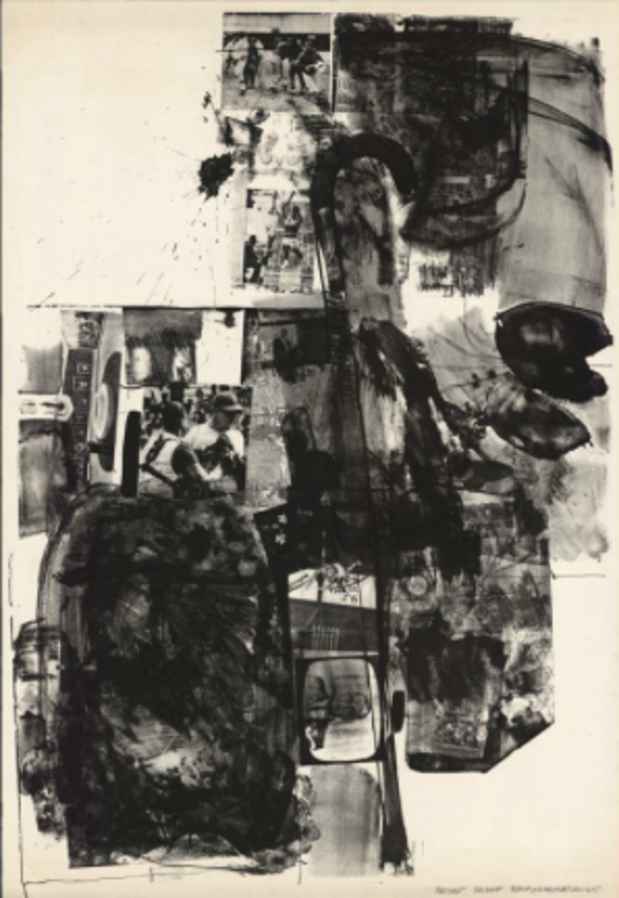Robert Rauschenberg “Outside the Box: Rare, Experimental & Groundbreaking Work from Four Decades”
Jim Kempner Fine Art

[Image: Robert Rauschenberg "Post Rally” (1965) Lithograph. 46 x 31 1/2”. Edition 42.]
This event has ended.
Jim Kempner Fine Art presents Outside the Box: Rare, Experimental and Groundbreaking Work from Four Decades. The exhibition features a selection of Robert Rauschenberg’s prints and multiples from a number of series spanning the 1960s through the 1990s. The selection showcases Rauschenberg’s unique and experimental approach to his art by way of unusual materials used, recontex- tualized imagery and his startlingly original processes.
When Tatyana Grossman, the founder of ULAE (Universal Limited Art Editions) approached Rauschenberg in the early 1960s about making original lithographs, he said “the second half of the twentieth century is no time to begin drawing on stones.” Luckily, he was coaxed by her charm and persistence, and by 1962 began experimenting on lithographic stones. A friend of Rauschenberg’s, who worked at The New York Times, gave him used photographic printer mats which he used to transfer the images onto the litho stone. These contemporary images were used along with direct mark making on the stone to create his first prints.
Rauschenberg used imagery from newspapers in the majority of his early work, sometimes repeating these images in multiple prints. An example of this can be seen in Rauschenberg’s iconic print Post Rally (1965). Post Rally was made using four of his seven Dante’s Inferno plates, (Kar, Rank, Sink & Mark), along with additional marks and scrapes. An image of a cane was added after Rauschenberg broke his foot during a theater performance. Those early editions bridged the space between abstract expressionism and Pop Art and are considered some of the most immediate and successful post-war American prints.
Rauschenberg’s Airport Series (1974) continues his use of newspaper imagery, allowing the viewer to see the newspaper page, both right reading and reversed. With this series, Rauschenberg printed these intaglio and relief plates on different fabrics, which were then sewn together with machine button-holes for mounting. Room Service includes images printed onto four different layered pieces of green muslin and white cotton. Each print in the edition includes one of the artist’s unique neckties sewn onto the collaged print and allowed to cascade down the center. Although Rauschenberg had used fabric since the 1950s as a part of his combine paintings, the Airport Series were his first multiples on fabric.
Bellini V (1989), a highlight from the 1980s, is part of the critically acclaimed Bellini series published by ULAE and first shown together at the 1990 Whitney Biennial. The series includes imagery from the small (12 x 8”) panel paintings of the 4 Allegories by Venetian Renaissance artist Giovanni Bellini. In Bellini V, Rauschenberg uses the allegorical image of Perseverance to make a large black and white photogravure, (five times the size of the original) to which he adds sections of his own contemporary photographs as well as abstract markings and shapes. Bellini V, a powerful artistic union between two masters, exhibits Rauschenberg’s remarkable sense of history and design.
Representing Rauschenberg’s later work is the mixed media composition Pegasits (1990), made with screenprint, wax, and polished steel with a painted wood chair. The piece was created during the Rauschenberg Overseas Cultural In- terchange (ROCI) project. ROCI (pronounced “Rocky,” the name of the artist’s pet turtle) was an international traveling show dedicated to human rights and the freedom of artistic expression. The ideas for the ROCI USA works originated when Rauschenberg and Don Saff, the project’s artistic coordinator, visited Kuala Lumpur Malaysia, a region known for its enormous tin reserves. Rauschenberg was fascinated by the crumpled metallic tin roofs of old homes there and began experimenting with Saff by screen printing images with wax on metal. Rauschenberg’s resulting Wax Fire Works were first shown at the National Gallery of Art in May 1991. Rauschenberg said the glistening surfaces “represented a kind of garish quality of American life.”
Robert Rauschenberg (b. 1925, Port Arthur, Texas; d. 2008, Captiva, Florida) is one of the most significant postwar American artists. He was an early innovator of contemporary American printmaking, challenging assumptions about art and pioneering new directions in assemblage and painting. He established the Robert Rauschenberg Foundation in 1990 to foster his belief that art can affect social change. The foundation supports artists, initiatives, and institutions that embody Rauschenberg’s fearless, innovative, and multidisciplinary approach to art and philanthropy. During his life, Rauschenberg’s work was the subject of numerous solo exhibitions, including an international retrospective launched at Tate Modern in 2016 that will be presented at The Museum of Modern Art, NY from May 21- September 4, 2017, and the San Francisco of Museum of Modern Art from November 4, 2017- March 25, 2018.
Media
Schedule
from May 04, 2017 to June 18, 2017
Opening Reception on 2017-05-04 from 18:00 to 20:00